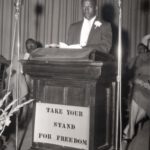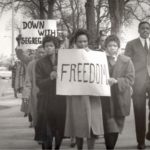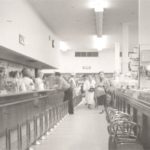Photographer Cecil Williams tells students about growing up in the segregated South
Note: The S.C. African American Heritage Foundation received an Arts in Education Project grant to help fund an artist residency featuring photographer Cecil Williams. Images above: The South Carolina Arts Commission’s State Art Collection includes three works by Williams. (click on an image for larger view.)
From SCNow.com
Article and photo by Joe Perry
LAMAR, S.C. – Life under segregation in South Carolina was not easy, but Cecil Williams was there with his camera, capturing history as it was made.
The 79-year-old Orangeburg native spoke on Jan. 9 to students at Lamar High School as part of a two-day residency that included a presentation that night at Black Creek Arts Council and an appearance at Mayo High School in Darlington. The residency is funded through the South Carolina African American Heritage Foundation and S.C. Arts Commission.
Williams got his first camera when he was 9 years old as his brother’s interests turned to music and playing the saxophone. Williams was instantly enthralled with the Kodak “Baby Brownie,” he said, and he figured out “a little hustle” early on. With 12 exposures, he’d go to Edisto Gardens to photograph couples. Developing the film cost a dollar.
“That means I would make 11 dollars,” he said, laughing.
His career and subject matter, though, soon turned to how he saw the disadvantages African-Americans faced. As part of his slideshow, Williams shared photos that reached millions of people through publications such as Life and Newsweek magazines and The New York Times, while his primary employer was JET magazine.
“How was it back then for African-Americans at the time?” he said. “When people, just because of the color of their skin, don’t have the same rights as other people?”
Williams was chased out of the courthouse in Orangeburg for taking a photo of a restroom marked “Colored.” Not one to shy away from controversy, he photographed a family victimized by the Ku Klux Klan. He told the students a cross was burned on their lawn because the grandson was deemed “sassy” for looking at a white person. His family’s heritage is Native American, Caucasian and African-American, he said, but they were considered people of color, and when a family trip to North Carolina came to a halt because their car broke down, they couldn’t find a place to stay.
“This was probably what would be I-95 today,” he said, showing a photo of the broken-down car and his family.
One of his most requested photos, he told the students, was from a march in downtown Orangeburg with students holding signs that said “FREEDOM” and “DOWN WITH SEGREGATION.” Another of his well-published photos depicted teachers in Elloree fired for refusing to disavow the NAACP. He recalled he was probably paid $50 for a photo, which was a significant amount at the time “and encouraged me to go forward.”
One of his most exciting times was personally meeting John F. Kennedy, then a Massachusetts senator who was aspiring to become president.
“I became a good acquaintance of him and shared my pictures with him,” he said, and Williams even wrangled a seat on Kennedy’s campaign plane as the lone member of the press.
The most pivotal time of his life and career came in 1968, several years after the landmark Civil Rights Act had been passed under President Lyndon B. Johnson.
“Everything had been opened up,” he said. “But not in Orangeburg, South Carolina.”
A bowling alley that was still segregated prompted a demonstration by students that resulted in a melee ending with the shooting deaths of three African-American men.
“Total disregard for human life,” he said. “They injured 27 and killed three young men, who were my friends, just because they wanted to bowl in a bowling alley, and they wanted the right to demonstrate.”
Whether it was the Orangeburg Massacre or demonstrations in Columbia and Charleston, Williams said, he wasn’t there solely to capture history.
“At the time it was unavoidable and, you might say, the thing to do,” he said. “Had I not been there with a camera, I would have been there as a student or participant myself. So I was an eyewitness and participant.”
At one point in his life, Williams said, he wanted to study architecture at Clemson University but wasn’t able to because of his skin color. He nonetheless designed several homes and has spent time with inventions as well; one of those, the Film Toaster, is something he spent years tinkering with. Used to digitize decaying negatives, the Film Toaster – patent pending – has allowed him to preserve his legacy and ensure his archives remain in good shape. With grant funding, there are five Claflin University students working with two Film Toasters to keep his historical record intact.
“I’m trying to show what it was like growing up in the middle of a revolution, one of the most significant revolutions of mankind,” Williams said. “It made America and the world a better place.”





